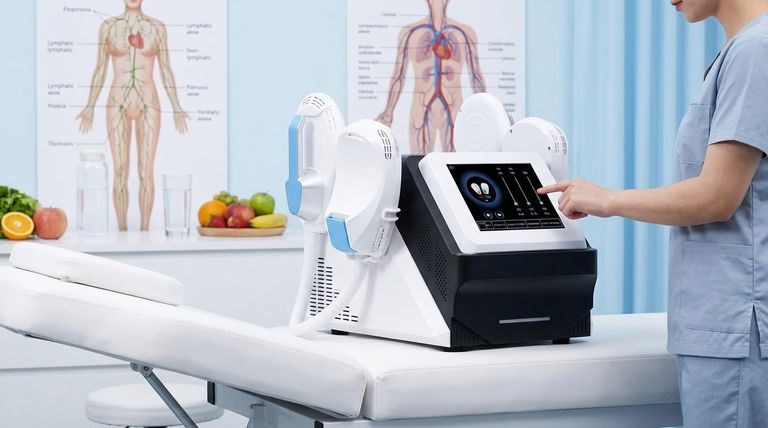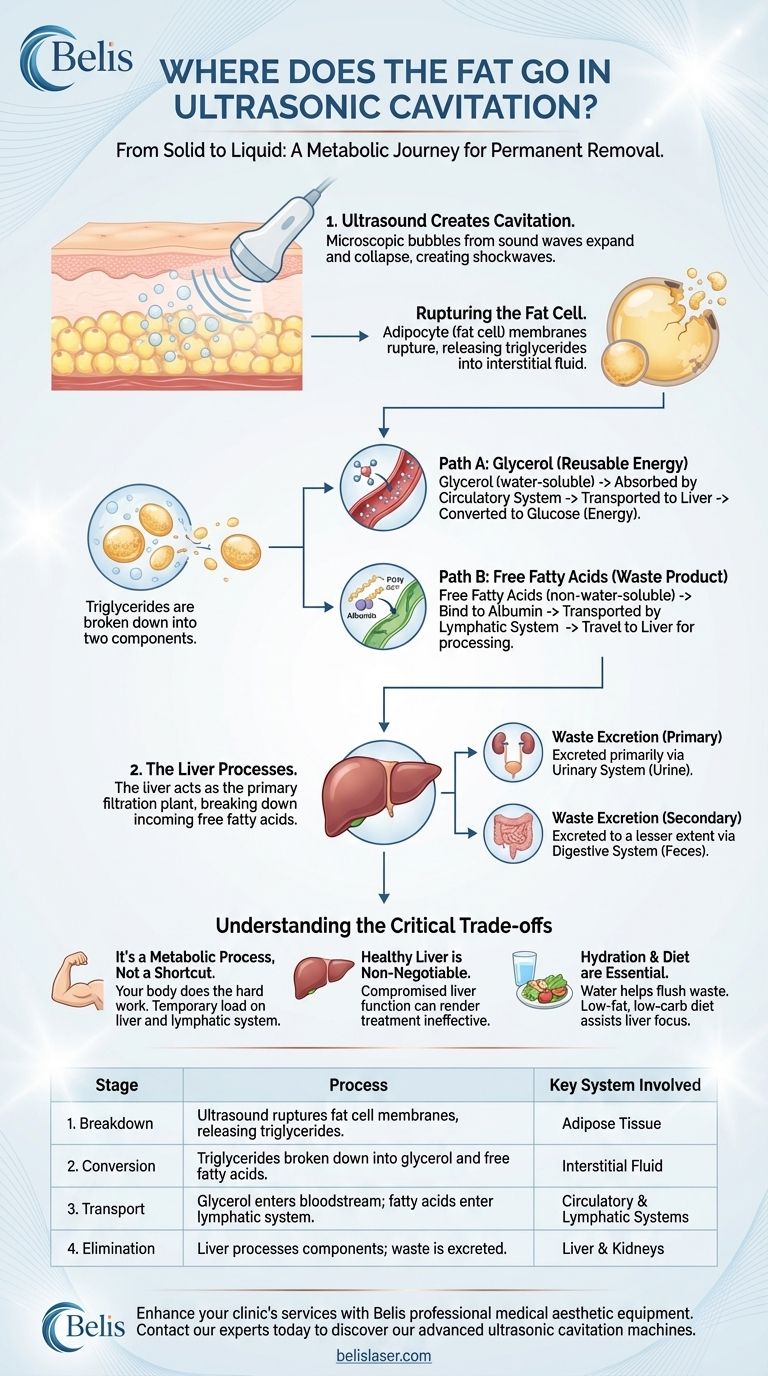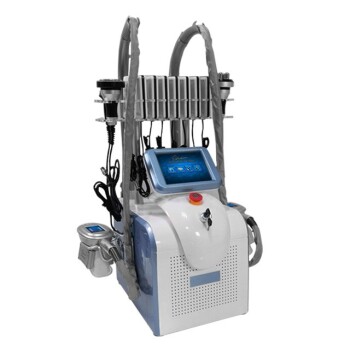When treated with ultrasonic cavitation, the targeted fat does not simply disappear. Instead, the procedure converts solid fat cells into liquid components that the body can process and eliminate through its own natural metabolic pathways. This process involves breaking down fat deposits into glycerol and free fatty acids, which are then transported by the lymphatic system to the liver for final disposal.
Ultrasonic cavitation is not a process of removal, but of conversion. It liquefies fat cells, releasing their contents into the body's natural filtration and waste systems to be permanently cleared.

The Initial Breakdown: From Solid Fat to Liquid
To understand where the fat goes, we must first understand how it's released. The procedure uses low-frequency ultrasound waves to target subcutaneous fat cells without affecting surrounding tissue.
How Ultrasound Creates "Cavitation"
The ultrasound energy creates microscopic bubbles in the fluid surrounding the fat cells.
As the sound waves continue, these bubbles rapidly expand and collapse. This implosion creates a localized shockwave that puts immense pressure on the fat cell membranes.
Rupturing the Fat Cell
The membranes of the adipocytes (fat cells) are not strong enough to withstand these vibrations and pressure changes.
This causes the cell membrane to rupture, releasing its contents—triglycerides—into the space between cells, known as the interstitial fluid.
The Two-Part Metabolic Journey
Once released, the triglycerides are broken down into two simpler components: glycerol and free fatty acids. Each component follows a different path.
Part 1: Glycerol (The Reusable Energy)
Glycerol is water-soluble and is quickly absorbed by the circulatory system.
Your body transports it to the liver, where it is converted into glucose. This provides a ready source of energy that your body can use immediately.
Part 2: Free Fatty Acids (The Waste Product)
The free fatty acids are not water-soluble and cannot travel through the bloodstream on their own.
They bind to a protein (albumin) and are transported to the lymphatic system, which acts as a secondary circulatory system and a key part of your immune response. From there, they travel to the liver.
The Liver's Critical Role
The liver is the body's primary filtration plant. It processes the incoming free fatty acids, breaking them down just as it would with fat from the food you eat.
Final Elimination
After the liver metabolizes these components, the waste products are excreted from the body. This happens primarily through the urinary system (urine) and, to a lesser extent, the digestive system.
Understanding the Critical Trade-offs
The process is effective, but it relies entirely on your body's existing infrastructure to work. Success is not guaranteed by the machine alone.
This Is a Metabolic Process, Not a Shortcut
Ultrasonic cavitation simply unlocks the fat from the cells. Your body must still do the hard work of processing and eliminating it.
A sudden release of fatty acids places a significant temporary load on your liver and lymphatic system.
A Healthy Liver is Non-Negotiable
If your liver function is compromised, it will struggle to process the influx of free fatty acids. This can render the treatment ineffective and potentially strain your system.
Hydration and Diet are Essential
Drinking significant amounts of water is crucial. It helps your kidneys and lymphatic system flush the processed waste products out of your body more efficiently.
Consuming a low-fat, low-carbohydrate diet after treatment prevents you from adding new fat that the liver has to process, allowing it to focus on clearing the byproducts of the cavitation.
Maximizing Your Results
Understanding this process allows you to make informed decisions and support your body for the best possible outcome.
- If your primary focus is safety: Confirm that you have healthy liver and kidney function before undergoing this procedure, as they are central to the fat elimination process.
- If your primary focus is effectiveness: Commit to significant water intake and a clean diet post-treatment to give your body the resources it needs to flush the released fat.
- If your primary focus is long-term maintenance: Recognize that cavitation removes existing fat but does not prevent the storage of new fat; a sustainable, healthy lifestyle is essential.
Ultimately, ultrasonic cavitation is a tool that accelerates a natural process, but your body's systems must perform the final, critical work.
Summary Table:
| Stage | Process | Key System Involved |
|---|---|---|
| 1. Breakdown | Ultrasound ruptures fat cell membranes, releasing triglycerides. | Adipose Tissue |
| 2. Conversion | Triglycerides are broken down into glycerol and free fatty acids. | Interstitial Fluid |
| 3. Transport | Glycerol enters the bloodstream; fatty acids enter the lymphatic system. | Circulatory & Lymphatic Systems |
| 4. Elimination | The liver processes components; waste is excreted via urine and feces. | Liver & Kidneys |
Ready to enhance your clinic's body contouring services with professional-grade technology?
BELIS specializes in professional medical aesthetic equipment, providing advanced ultrasonic cavitation machines to medical aesthetics clinics and premium beauty salons. Our devices are engineered for safety, efficacy, and superior patient outcomes.
Contact our experts today to discover how our equipment can become a cornerstone of your treatment offerings and drive your business growth.
Visual Guide

Related Products
- EMSlim Body Sculpting Machine EMS Body Slimming Machine
- Ultrasonic Cavitation Radiofrecuency Machine for Body Slimming
- EMSlim RG Laser Body Sculpting and Slimming Machine
- Cryolipolysis Fat Freezing Machine Ultrasonic Cavitation Fat Reducing Device
- EMS Body Sculpting Machine for Body Slimming and Sculpting
People Also Ask
- How many sessions of ultrasonic liposuction are needed? Achieve Optimal Body Contouring
- Is EMSlim safe? Ensuring Your Safety in Non-Invasive Body Contouring
- Does EMS actually work for weight loss? A Realistic Look at Muscle Building and Metabolism
- Does EMS sculpting really work? Achieve Clinically-Proven Body Contouring
- What are the side effects of ultrasound fat reduction? Minimize Risks for Safe Body Contouring



















